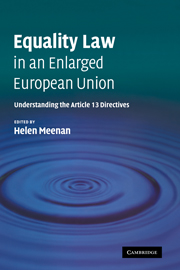Book contents
- Frontmatter
- Contents
- Preface
- Acknowledgements
- List of contributors
- Abbreviations
- Table of Cases
- PART I
- PART II
- 5 EU sex equality law post-Amsterdam
- 6 EU anti-racism policy; the leader of the pack?
- 7 Religion or belief; aiming at the right target?
- 8 Disability discrimination law in the European Union
- 9 Age discrimination – Of Cinderella and The Golden Bough
- 10 The ‘mainstreaming’ of sexual orientation into European equality law
- 11 Conclusion
- Index
5 - EU sex equality law post-Amsterdam
Published online by Cambridge University Press: 22 August 2009
- Frontmatter
- Contents
- Preface
- Acknowledgements
- List of contributors
- Abbreviations
- Table of Cases
- PART I
- PART II
- 5 EU sex equality law post-Amsterdam
- 6 EU anti-racism policy; the leader of the pack?
- 7 Religion or belief; aiming at the right target?
- 8 Disability discrimination law in the European Union
- 9 Age discrimination – Of Cinderella and The Golden Bough
- 10 The ‘mainstreaming’ of sexual orientation into European equality law
- 11 Conclusion
- Index
Summary
Introduction
This chapter focuses on the development of sex equality law since the Amsterdam Treaty. The most important feature of the Amsterdam Treaty from the perspective of this book was of course the new Article 13, providing a legal basis for Community institutions to take action to combat discrimination not only on the grounds of sex but on a whole range of other grounds and within any area of Community activities. However, Article 2, as amended, Article 3(2) and Article 141 EC (see further below) are also of special interest to sex equality law, following the Amsterdam Treaty. It is also worth mentioning the new Title VIII (ex Title VIa) on employment introducing the ‘open method of coordination’ for employment guidelines now also extended to other areas of social cohesion. Finally, there is the inclusion of the Maastricht Social Protocol and the new rules on the Social Dialogue in Articles 137–139 EC. All of these new rules play an intrinsic role for the post-Amsterdam developments of sex equality law. To understand the development of sex equality law following the Amsterdam Treaty, its relationship with Article 13 EC and action taken on this basis it is, however, necessary to start with some remarks on the unique features of sex equality regulation in an EC law context and its roots pre-Amsterdam. After introducing these features, I will continue to describe the legal developments in the field of sex equality post Amsterdam only to end up in a discussion on the future implications of discrimination law developments in general for gender equality.
- Type
- Chapter
- Information
- Equality Law in an Enlarged European UnionUnderstanding the Article 13 Directives, pp. 145 - 177Publisher: Cambridge University PressPrint publication year: 2007
- 2
- Cited by



